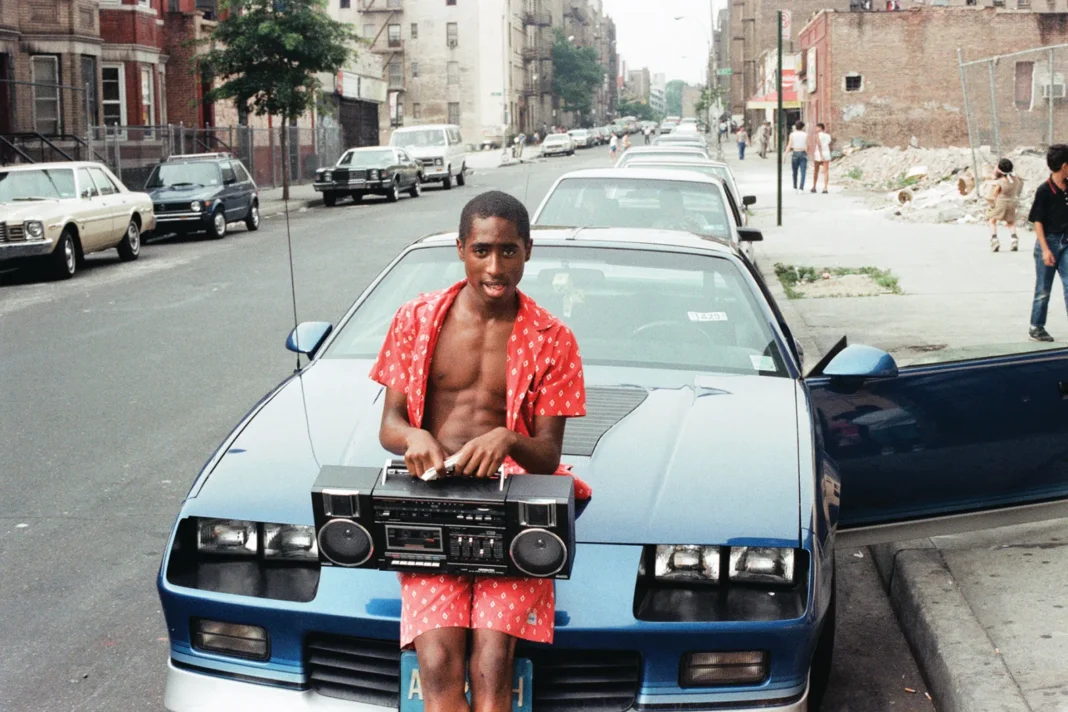The rats came at night, toaster-sized and fearless, crawling through gaping holes in the kitchen floor. Fourteen-year-old Tupac Shakur would lie on his mattress in a coffin-sized bedroom, listening to their haunting shuffle, knowing they were eating the food his family couldn’t afford to replace. In a row house with no heat, no phone, and walls so thin that Baltimore’s bitter winter air felt like an uninvited guest, the future icon of hip-hop learned his first lesson in survival: when reality is unbearable, create a new one. Armed with three thick binders crammed with poetry and a battered boom box, Tupac began transforming his trauma into art—rap as escape, poetry as salvation. While his classmates at Dunbar High mocked his duck-footed walk, stained teeth, and thrift-store Lee jeans, Tupac was engineering something revolutionary: a creative voice that would refuse to separate poetry from rap, pain from power, or vulnerability from strength.
The story of Tupac Shakur typically begins with the bandana, the thug life aesthetic, or the East Coast-West Coast rivalry that would ultimately claim his life. But the true genesis of hip-hop’s most complex and enduring icon lies in a forgotten chapter, buried in the working-class neighborhoods of Baltimore where a traumatized boy turned suffering into syllables, hunger into verses, and humiliation into a revolutionary artistic philosophy. This is the story of how poverty and poetry collided to create a legend.
The Baltimore No One Writes About
When thirteen-year-old Tupac arrived in Baltimore in November 1984, he stepped into a city that existed in two parallel realities. There was the Baltimore of gleaming Inner Harbor redevelopment and revitalized downtown districts, the city that politicians and developers showcased to the world. Then there was the Baltimore of Greenmount Avenue, where the Shakur family’s dilapidated row house at number 3955 stood as a monument to urban neglect.
The Pen Lucy neighborhood offered no welcome wagon, no promise of better days. For Tupac, his mother Afeni, and half-sister Set, the move from New York represented not opportunity but desperation—a lateral shift between equally punishing forms of poverty. The row house they inhabited was less a home than a bare-bones shelter, its broken infrastructure a daily reminder of their precarious existence. Without heat during Baltimore’s unforgiving winters, the family huddled together for warmth. The rats that invaded through floor gaps weren’t occasional visitors but permanent residents with more claim to the space than the humans who paid rent.
This environment would have crushed a lesser spirit. For Tupac, it became the forge where his artistic identity was hammered into being. The psychological mechanism at work was one that trauma specialists recognize in survivors who channel pain into creative output: the transformation of unbearable reality through artistic sublimation. Where others might have surrendered to despair, Tupac reached for his notebooks.
The Alchemy of Suffering
Child psychologists and trauma researchers have long studied the phenomenon of children who develop extraordinary creative capacities in response to adverse circumstances. What they’ve found challenges conventional wisdom about the relationship between comfort and creativity. While stable environments certainly benefit child development, some individuals exposed to significant hardship develop what experts call “adaptive creativity”—the ability to mentally construct alternative realities as a coping mechanism.
Tupac’s three binders of poetry represented more than teenage journaling. They were survival tools, psychological armor against a world that seemed designed to break him. Every page filled was an act of defiance, every verse written was evidence that his mind remained his own even when his circumstances were dictated by poverty, addiction, and systemic failure.
The poetry itself, according to those who witnessed this period, revealed a mind operating at levels far beyond typical adolescent expression. While his peers at Roland Park Middle School and later Paul Laurence Dunbar High School were navigating the standard concerns of teenage life, Tupac was grappling with themes of mortality, injustice, maternal love complicated by addiction, and the soul-crushing weight of poverty. His writing didn’t shy from darkness—it interrogated it, challenged it, and ultimately transcended it through the sheer force of linguistic craft.
The Classroom as Battlefield
Educational environments often serve as equalizers, spaces where intellect and talent can override socioeconomic disadvantage. But for Tupac, school became another arena of humiliation. His classmates at Dunbar High School zeroed in on every marker of his poverty: the duck-footed walk that suggested inadequate childhood nutrition, the dental work that betrayed lack of proper healthcare, the Lee jeans from thrift stores while others wore name brands.
Bullying in adolescence leaves scars that many carry into adulthood, and the particular cruelty of class-based mockery cuts deeper than most realize. To be bullied for things beyond your control—your family’s poverty, your mother’s addiction, your inability to afford what others take for granted—creates a specific kind of psychic wound. It reinforces the lie that poverty is personal failure, that suffering is deserved.
Yet this crucible of humiliation also revealed something extraordinary about Tupac’s character: his refusal to internalize shame. Rather than accepting his classmates’ judgment, he doubled down on his art. The talent show victory became a watershed moment, a public declaration that the boy they mocked possessed gifts they couldn’t touch. When he performed, the duck-footed walk transformed into stage presence. The stained teeth disappeared behind commanding delivery. The thrift-store aesthetic became irrelevant in the face of undeniable talent.
Hip-Hop as Salvation
The formation of the East-Side Crew with friend Dana “Mouse” Smith marked Tupac’s transition from private poet to public performer. In the mid-1980s, hip-hop was still defining itself, still proving it was more than a passing fad. Baltimore’s hip-hop scene, while smaller than New York’s or Los Angeles’, offered fertile ground for young artists willing to take risks.
Tupac’s first professional show in February 1985, opening for Mantronix at Cherry Hill Recreation Center, represented more than a teenage gig. It was validation that the art he’d been crafting in solitude could resonate publicly, that the poetry filling his binders could translate into performance that moved crowds. For a boy whose home life offered little stability or affirmation, the response of an audience became life-sustaining feedback.
What distinguished Tupac from other young rappers was his fundamental belief that rap and poetry were inseparable art forms. While many saw rap as primarily musical performance with rhyming lyrics, Tupac understood it as poetry delivered with rhythm, as linguistic craft elevated by beat and flow. This philosophy, radical for its time, would eventually reshape how hip-hop artists approached their craft. The idea that rappers were poets, that their work deserved literary analysis and critical respect, gained traction partly because artists like Tupac refused to accept the artificial boundary between high and low art.
The Mother in the Shadows
No examination of Tupac’s Baltimore years can ignore Afeni Shakur’s presence—or sometimes absence—during this period. A former Black Panther who defended herself in court while pregnant with Tupac, Afeni possessed intelligence, political consciousness, and fierce love for her children. She also battled crack addiction during some of the hardest years of the epidemic’s devastation of Black urban communities.
The complexity of loving a parent struggling with addiction creates a particular kind of anguish for children. Tupac’s relationship with his mother during this period was by all accounts fraught with the contradictions inherent in such circumstances: devotion mixed with disappointment, admiration alongside anger, fierce protectiveness coexisting with the pain of being unable to save her from herself.
This dynamic profoundly influenced Tupac’s artistic voice. His later work would explore maternal love with nuance rarely seen in hip-hop, acknowledging both the beauty and the pain, the strength and the fragility. The seeds of that complex understanding were planted in Baltimore, in a house where love existed but safety didn’t, where family meant everything but couldn’t solve anything.
The Long Shadow of Baltimore
By the time Tupac left Baltimore for California, the city had fundamentally shaped the artist he would become. The poverty, the bullying, the rats and the cold and the hunger—none of it was wasted. Every hardship became material, every humiliation transformed into motivation, every dark night converted into verses that would eventually reach millions.
Urban historians who study Baltimore’s 1980s landscape recognize the period as one of particularly acute crisis. The crack epidemic was devastating communities, manufacturing jobs were disappearing, and the racial wealth gap was widening into a chasm. The “Two Baltimores” phenomenon—one prosperous and predominantly white, one struggling and predominantly Black—created parallel realities where geography determined destiny.
Tupac’s experience in Pen Lucy wasn’t unique; thousands of families navigated similar circumstances. What distinguished him was his response to those circumstances, his refusal to let poverty define his potential, his determination to document and transcend his reality through art.
Legacy of the Binders
Those three thick binders of poetry that Tupac carried everywhere during his Baltimore years represent something profound about artistic development. Mastery requires practice, and prolific output during formative years creates neural pathways that support later creativity. Malcolm Gladwell popularized the concept of ten thousand hours needed for expertise, but the principle extends beyond mere time investment. Quality practice, particularly during adolescence when the brain remains highly plastic, establishes foundations for lifetime achievement.
Contemporary rappers and poets who study Tupac’s work often point to the sophistication of his wordplay, the depth of his metaphors, and the authenticity of his emotional expression. These skills weren’t innate gifts dropped from the sky—they were forged through relentless practice, through filling page after page in those binders while sitting in a freezing house, through treating writing as both craft and salvation.
The revolutionary idea that rap and poetry were one art form, that hip-hop deserved critical respect as literature, has now become conventional wisdom. But in 1985 Baltimore, when a bullied teenager with stained teeth insisted on this unity, it was radical vision. Tupac didn’t just practice his art—he theorized it, understood it, and elevated it through his insistence that the streets could produce poetry as valid as any taught in classrooms.
Conclusion: The Crucible’s Gift
The narrative of Tupac Shakur that emerged after his death often emphasizes the contradictions: the sensitive poet who embraced thug life, the revolutionary thinker who signed to Death Row, the prophetic voice who couldn’t escape the cycle of violence he documented. But perhaps these weren’t contradictions at all. Perhaps they were the inevitable complexities of a man forged in Baltimore’s harshest crucible, where survival required both vulnerability and armor, where hope coexisted with rage, where poetry was simultaneously escape and engagement.
The row house on Greenmount Avenue no longer stands, demolished like so many monuments to urban poverty. But what happened inside those walls between 1984 and 1986 echoes still through hip-hop’s evolution, through every rapper who treats their lyrics as literature, through every artist who refuses to separate personal pain from public performance, through every young person who discovers that the worst circumstances can forge the strongest voices.
Tupac Shakur didn’t succeed despite his Baltimore poverty—he was shaped by it, tempered by it, and ultimately transcended it through the transformative power of artistic practice. The rats and the cold and the hunger were real, but so were the binders, the verses, the relentless belief that words could remake worlds. That belief, born in Baltimore’s darkness, would eventually illuminate stages around the globe. The boy who survived Greenmount Avenue became the icon who refused to die, whose voice still speaks to anyone who has ever transformed pain into power through the alchemy of art.



